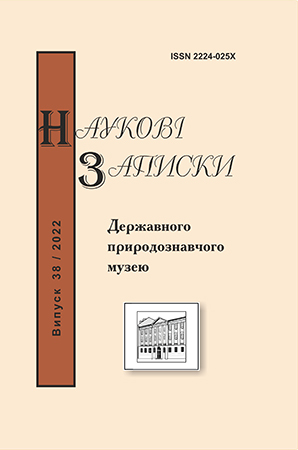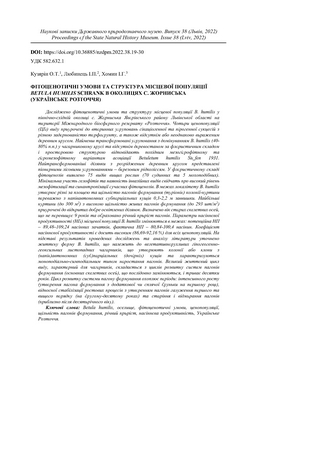Main
/
/
Kuzyarin O.T., Lyubynets I.P., Khomyn I.G.
Phytocenotic conditions and structure of the local population for Betula humilis Schrank near Zhornyska village (Ukrainian Roztochchia) // Proc. of the State Nat. Hist. Mus. - Lviv, 2022. - 38. - P. 19-30 DOI: https://doi.org/10.36885/nzdpm.2021.38.19-30 Key words: Betula humilis, habitat, phytocenotic conditions, coenopopulations, density of formation shoots, annual growth of shoots, seed productivity, Ukrainian Roztochchia. Phytocoenotic conditions and structure of the local population for Betula humilis in the north-eastern environs of the village Zhornyska, Yavoriv district, Lviv region, on the territory of the Roztochchia International Biosphere Reserve have been studied. Four coenopopulations (CP) of the species are confined to secondary plant communities of sicaciogenic and pyrogenic successions with different sod levels of the peat soil, as well as missing or unequally expressed tree layer. The least transformed communities with the dominance of B. humilis (40-80% p.c.) in the shrub layer and no stands in terms of floristic composition and spatial structure correspond to the derived mesohygrophytic and hygromesophytic variants of the association Betuletum humilis Steffen 1931. The most transformed areas with sparse tree layer are represented by pioneer forest communities - birch woodlands. Seventy-five species of higher plants (seventy vascular plants and five bryophytes) were found in the floristic composition of phytocenoses. The minimal participation of helophytes and the presence of invasive species indicate a high level of mesophytization and synanthropization of modern phytocenoses. Within the locality B. humilis forms different in area and density of formation shoots (turions) of the colony-curtain mainly from semi-autonomous subpartial bushes 0.3-2.2 m tall. The largest curtains (up to 300 m2) with a high density of living formation shoots (up to 293 pcs/m2) are confined to open well-lit areas. The age of old skeletal axis, not exceeding 9 years was determined and the annual growth of shoots has been calculated. The parameters of seed productivity (SP) of the local population of B. humilis vary within: potential SP - 89.48–109.24 seed germs, actual SP - 80.84–100.4 seeds. The coefficient of seed productivity is quite high (86.69-92.16%) for all coenopopulations. Based on the results of research and analysis of the literature the life form of B. humilis, which belongs to vegetatively mobile hypogeogenic-geoxyl deciduous shrubs that form colonies or clones of (semi) autonomous (sub) partial (daughter) shrubs and are characterized by monopodial-sympodial shoots growth has been clarified. The big life cycle of the species characteristic of shrubs consists of development cycles for systems shoots formation (main skeletal axes), which are successively replaced, and lasts for decades. The development cycle of the system formation shoot covers the periods of intensive growth (appearance of formation shoot from an additional or dormant bud in the first year), relative stabilization of growth processes with the formation of first and higher-order branching shoots (from second to tenth years) and ageing and death of shoots (after about ten years of age).
Phytocenotic conditions and structure of the local population for Betula humilis Schrank near Zhornyska village (Ukrainian Roztochchia) // Proc. of the State Nat. Hist. Mus. - Lviv, 2022. - 38. - P. 19-30 DOI: https://doi.org/10.36885/nzdpm.2021.38.19-30 Key words: Betula humilis, habitat, phytocenotic conditions, coenopopulations, density of formation shoots, annual growth of shoots, seed productivity, Ukrainian Roztochchia. Phytocoenotic conditions and structure of the local population for Betula humilis in the north-eastern environs of the village Zhornyska, Yavoriv district, Lviv region, on the territory of the Roztochchia International Biosphere Reserve have been studied. Four coenopopulations (CP) of the species are confined to secondary plant communities of sicaciogenic and pyrogenic successions with different sod levels of the peat soil, as well as missing or unequally expressed tree layer. The least transformed communities with the dominance of B. humilis (40-80% p.c.) in the shrub layer and no stands in terms of floristic composition and spatial structure correspond to the derived mesohygrophytic and hygromesophytic variants of the association Betuletum humilis Steffen 1931. The most transformed areas with sparse tree layer are represented by pioneer forest communities - birch woodlands. Seventy-five species of higher plants (seventy vascular plants and five bryophytes) were found in the floristic composition of phytocenoses. The minimal participation of helophytes and the presence of invasive species indicate a high level of mesophytization and synanthropization of modern phytocenoses. Within the locality B. humilis forms different in area and density of formation shoots (turions) of the colony-curtain mainly from semi-autonomous subpartial bushes 0.3-2.2 m tall. The largest curtains (up to 300 m2) with a high density of living formation shoots (up to 293 pcs/m2) are confined to open well-lit areas. The age of old skeletal axis, not exceeding 9 years was determined and the annual growth of shoots has been calculated. The parameters of seed productivity (SP) of the local population of B. humilis vary within: potential SP - 89.48–109.24 seed germs, actual SP - 80.84–100.4 seeds. The coefficient of seed productivity is quite high (86.69-92.16%) for all coenopopulations. Based on the results of research and analysis of the literature the life form of B. humilis, which belongs to vegetatively mobile hypogeogenic-geoxyl deciduous shrubs that form colonies or clones of (semi) autonomous (sub) partial (daughter) shrubs and are characterized by monopodial-sympodial shoots growth has been clarified. The big life cycle of the species characteristic of shrubs consists of development cycles for systems shoots formation (main skeletal axes), which are successively replaced, and lasts for decades. The development cycle of the system formation shoot covers the periods of intensive growth (appearance of formation shoot from an additional or dormant bud in the first year), relative stabilization of growth processes with the formation of first and higher-order branching shoots (from second to tenth years) and ageing and death of shoots (after about ten years of age).
References
- Бойко М.Ф. 2008. Чекліст мохоподібних України. Херсон : Айлант. 232 с.
- Вайнагий И.В. 1973. Методы статистической обработки материала по семенной продуктивности растений на примере Potenthilla aurea L. Растительные ресурсы. Т. 9 Вып. 2. С. 287–296.
- Вайнагий И.В. 1974. Семенная продуктивность и всхожесть семян некоторых высокогорных ратений Карпат. Бот. журн. Т. 59 № 10. С. 1439–1450.
- Жижин М.П., Кагало О.О., Чабан Х.І. 1988. Рослинність урочища "Заливки" заповідника "Розточчя". Укр. ботан. журн. Т. 45 № 1. С. 68–73.
- Жижин Н.П., Кагало А.А. 1989. Структура ценопопуляций и особенности охраны березы низкой Betula humіlіs Schrank) в заповеднике "Росточье". Популяционные исследования растений в заповедниках. Москва : Наука. С. 88–104.
- Зайцев Г.Н. 1973. Методика биометрических расчетов. Математическая статистика в экспериментальной ботанике. Москва : Наука. С. 34–45.
- Зелена книга України. 2009. Під заг. ред. Я.П. Дідуха. Київ : Альтерпрес. 448 с.
- Любинець І.П., Хомин І.Г. 2020. Нова знахідка Betula humilis Schrank на території Українського Розточчя // The 13th International scientific and practical conference «Science and Technology» (December 21-22, 2020) Nika Publishing, Manchester, Great Britain. С. 87–92.
- Мазуренко М.Т., Хохряков А.П. 1977. Структура и морфогенез кустарников. Москва : Наука. 160 с.
- Мельник В.І., Савчук Л.А. 2007. Береза низька (Bеtula humilis Schrank) в Україні. Луцьк : РВВ «Вежа» Волин. держ. ун-ту ім. Лесі Українки. 136 с.
- Мельник В.І., Савчук Л.А. 2009. Береза низька – Betula humilis Schrank.: Червона книга України. Рослинний світ / за ред. Я.П. Дідуха. Київ : Глобалконсалтинг. 900 с.
- Определитель высших растений Украины / Д.Н. Доброчаева, М.И. Котов, Ю.Н. Прокудин (отв. ред.) и др. 1987. Киев : Наук. думка. 548 с.
- Программа и методика наблюдений за ценопопуляциями видов растений Красной книги СССР. 1985. Москва. 34 с.
- Савчук Л.А. 2006. Betula humilis в Україні (еколого-ценотичні особливості, структура популяцій, наукові основи охорони). Дисертація кандидата наук, Національний ботанічний сад ім. М.М. Гришка НАН України. Київ. 142 с.
- Серебряков И.Г. 1964. Жизненные формы высших растений. В кн.: Полевая геоботаника. М.–Л. : Изд-во АН СССР. Том 3. С 300–432.
- Сорока М.І. 2008. Рослинність Українського Розточчя: Монографія. Львів : Світ. 434 с.
- Ткачик В.П. 1999. Рослинність заповідника «Розточчя»: класифікація методом Браун-Бланке. Львів : НТШ. 198 с.
- Флора УРСР. 1952. Київ : вид-во АН Української РСР. Т. 4. С. 32–33.
- Ценопопуляции растений. 1976. Москва : Наука. 216 с.
- Ященко П.Т., Матейчик В.І., Турич В.В. 2006. Береза низька (Betula humilis Schrank) та заходи щодо збереження її ценопопуляцій // наук.-практ. конф. «Лісівництво України в контексті світових тенденцій розвитку лісового господарства», присвяч. 150-річчю витоків кафедри лісівництва НЛТУ України. Львів : НЛТУ України. Збірник матеріалів. С. 262–264.
- Jabłońska Ewa. 2009. Brzoza niska Betula humilis Schrank w Polsce – status fitocenotyczny, warunki siedliskowe, zagrożenia i ochrona. Praca doktorska wykonana pod kierunkiem prof. dr hab. Stanisława Kłosowskiego w Zakładzie Ekologii Roślin i Ochrony Środowiska w Instytucie Botaniki na Wydziale Biologii Uniwersytetu Warszawskiego. Warszawa, lipiec 2009. 245 s.
- Jabłońska Ewa. 2012. Vegetation with Betula humilis in Central Europe. Phytocoenologia. 42 (3-4). S. 259–277. DOI: 10.1127/0340-269X/2012/0042-0527. 259–277
- Król Ż. 1877. Sprawozdanie z wycieczki w okolice Janowa pod Lwowem na obszarze od żródeł Wereszycy aż po jej bieg dolny w najbliższych okolicach Gródka odbytej w roku 1875. Sprawozdanie Komisji Fizjograficznej. T. 11. S. 3–33.
- Matuszkiewicz W. 2001. Przewodnik do oznaczania zbiоrowisk roślinnych Polski. Warszawa : PWN. 537 s.
- Mucina L. 1997. Conspectus of classes of European vegetation. Folia Geobot. Phytotax. 32. P. 117–172.
- Oberdorfer E. 1965. Zur Soziologie der Betula humilis und Betula pubescens. Materiały Zakładu Fitosocjologii Stosowanej UW. 6. S. 43–52.
- Schubert R., Hilbig W., Klotz S. 2001. Bestimmungsbuch der Pflanzengesellschaften Deutschlands. Heidelberg : Spektrum, Akad. Verl. 472 s.


